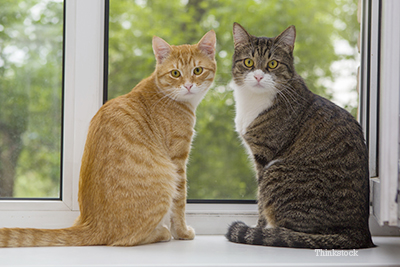 Have you ever heard of pheromones? Perhaps your veterinarian recommended pheromone therapy for a behavioral concern in your dog or cat? The simplest definition of a pheromones is “chemicals secreted by animals.” More specifically it’s a chemical compound, produced and secreted by an animal, that influences the behavior and development of other members of the same species. In recent years chemicals known as pheromones have been synthesized allowing for their potential widespread use.
Have you ever heard of pheromones? Perhaps your veterinarian recommended pheromone therapy for a behavioral concern in your dog or cat? The simplest definition of a pheromones is “chemicals secreted by animals.” More specifically it’s a chemical compound, produced and secreted by an animal, that influences the behavior and development of other members of the same species. In recent years chemicals known as pheromones have been synthesized allowing for their potential widespread use.
These chemicals have a wide variety of functions and have been found to be produced by a number of species from insects to humans. They impact behavior and emotions by means of unspoken and even non-tactile communications. They are believed to be common and important in coordinating social behavior in animals, especially mammals. The role, if any that they play in human behavior, is less clear.
Behavioral problems, such as fear and aggression in dogs and elimination in the house for both dogs and cats, are a major reason why people euthanize their pets. In dogs and cats these extreme reactions often require medical or behavioral intervention. Behavioral modification can be difficult and time consuming particularly if the undesirable behavior has been allowed to persist and become ingrained. Early recognition and intervention is important and simple interventions can be very successful.
Using pheromones for therapy
In recent years the study of pheromones has ushered in a new interest in potential form of behavioral therapy in dogs and cats. Some of the most challenging therapeutic problems that veterinarians and pet owners deal with are behavioral problems, many of which are really exaggerations of normal behaviors that impact the relationships between animals and their owners. One of these interventions is the use of pheromones. These chemical messengers are transported outside of the body and have the effect of impacting physiological changes, inflammatory signaling, immune system changes and/or behavioral changes.
The most common products are Feliway®, an analogue of the facial pheromone cats leave behind on furniture and people they rub their faces against, and DAP, short for Dog Appeasing Pheromones, a pheromone nursing mothers release, which is believed to calm puppies.
Although widely used and anecdotally praised there is little scientific support for the efficacy of these products. That said my personal experience in the use of pheromone collars in cats has been extremely rewarding and other anecdotal reports indicate the product is deserving of more study and is certainly worth trying. It is harmless and if it works in a given situation it is worth the effort and cost.
That said, I agree with the writer of Skeptvet1 that we need to temper our enthusiasm and acknowledge the limited evidence of efficacy that exists.
1. "Pheromone Therapy for Dogs and Cats – What’s the Evidence?" The Skeptvet. 22 June 2010.
If you have any questions or concerns, you should always visit or call your veterinarian -- they are your best resource to ensure the health and well-being of your pets.
